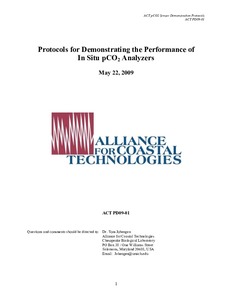Protocols for Demonstrating the Performance of In Situ pCO2 Analyzers.

View/
Average rating
votes
Date
2009Author
Johengen, T.
Status
PublishedPages
12pp.
Metadata
Show full item recordAbstract
There are three important reasons for measuring pCO2
continuously from coastal
moorings. The first is to evaluate whether coastal oceans are functioning as a source or a sink of
atmospheric CO2. The open ocean and more distal parts of the shelves are
reasonably well
characterized as either typical CO2
sinks or sources (Takahashi et al., 2009), while the inner
shelves are most variable and (with a general predominance of a source function)
least well
constrained; coastal areas are expected to be rather vulnerable to climate change in the 21st
century. This of course has direct consequence of managing CO2
as a pollutant. Near continuous
measurements of pCO2
will provide some understanding of the fluxes, their variability and their
forcing parameters. The second reason involves the changes in saturation state of the water with
respect to carbonate minerals and the impact on calcifying ecosystems. Surface pCO2
measurements in conjunction with direct measureme.....
Resource URL
http://www.act-us.info/evaluations.phpPublisher
Alliance for Coastal Technologies (ACT)Solomons, MD
Series;Nr
ACT PD; 09-01Document Language
enEssential Ocean Variables (EOV)
Dissolved organic carbonBest Practice Type
Best PracticeStandard Operating Procedure
Citation
Johengen, T. (2009) Protocols for Demonstrating the Performance of In Situ pCO2 Analyzers. Solomons, MD, Alliance for Coastal Technologies, 12pp. (ACTPD09-01). DOI: http://dx.doi.org/10.25607/OBP-334Collections
The following license files are associated with this item:
 Repository of community practices in Ocean Research, Applications and Data/Information Management
Repository of community practices in Ocean Research, Applications and Data/Information Management
